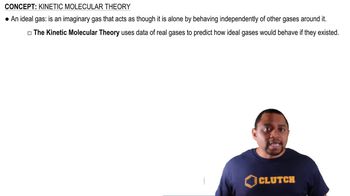You have a sample of gas in a container with a movable piston, such as the one in the drawing. (b) Redraw the container to show what it might look like if the external pressure on the piston is increased from 101.3 kPa to 202.7 kPa while the temperature is kept constant.
Which of the following statements best explains why nitrogen gas at STP is less dense than Xe gas at STP? (a) Because Xe is a noble gas, there is less tendency for the Xe atoms to repel one another, so they pack more densely in the gaseous state. (b) Xe atoms have a higher mass than N2 molecules. Because both gases at STP have the same number of molecules per unit volume, the Xe gas must be denser. (c) The Xe atoms are larger than N2 molecules and thus take up a larger fraction of the space occupied by the gas. (d) Because the Xe atoms are much more massive than the N2 molecules, they move more slowly and thus exert less upward force on the gas container and make the gas denser.
 Verified step by step guidance
Verified step by step guidanceKey Concepts
Density and Molar Mass

Ideal Gas Law

Kinetic Molecular Theory

Consider the sample of gas depicted here. What would the drawing look like if the volume and temperature remained constant while you removed enough of the gas to decrease the pressure by a factor of 2? (a) It would contain the same number of molecules. (b) It would contain half as many molecules. (c) It would contain twice as many molecules. (d) There is insufficient data to say.
Imagine that the reaction 2 CO1g2 + O21g2¡2 CO21g2 occurs in a container that has a piston that moves to maintain a constant pressure when the reaction occurs at constant temperature. Which of the following statements describes how the volume of the container changes due to the reaction: (a) the volume increases by 50%, (b) the volume increases by 33%, (c) the volume remains constant, (d) the volume decreases by 33%, (e) the volume decreases by 50%.
The apparatus shown here has two gas-filled containers and one empty container, all attached to a hollow horizontal tube. When the valves are opened and the gases are allowed to mix at constant temperature, what is the distribution of atoms in each container?
The apparatus shown here has two gas-filled containers and one empty container, all attached to a hollow horizontal tube. Assume that the containers are of equal volume and ignore the volume of the connecting tube. Which gas has the greater partial pressure after the valves are opened?
